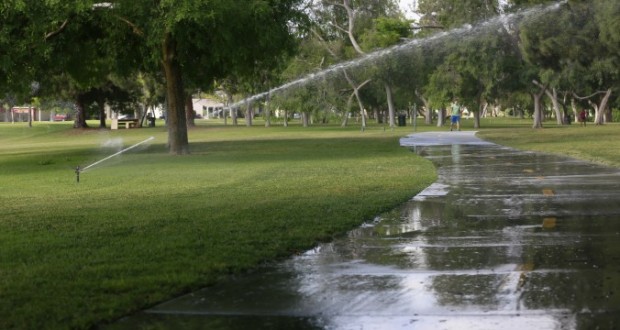By McKenzie Jackson, California Black Media
The harsh drought that has dried up the Golden State over the past three years has severly hit one California community particularly hard. Allensworth, the historic and only town founded, financed and governed by African Americans in Tulare County knows all too well the impacts of no rain, coupled with the contamination of city’s ground water supply by arsenic, the shortage of the water crisis is a blunt one-two punch for the town of a little more than 60,000 people.
Residents of the rural, mostly migrant community began receiving drought relief food early last summer and in January the state began delivering 48 gallons of drought relief water to households each month.
Denise Kadara, one of Allensworth’s few black residents, said the situation is dire but it could be worse.
“I know you have heard of East Porterville where a lot of the wells have gone dry,” she said. “We aren’t experiencing that yet. Our water systems are so old that they break. We just had a break in our system about six weeks ago, but luckily we had bottle water. Otherwise, we would have been 12 hours without water.”
Kadara’s East Porterville reference compares her city to the other Tulare County town where more than 1,000 private wells residents depended on for their water supply have completely dried up.
In response to the state’s record-breaking drought – the worst in more than 60 years according to experts – Governor Jerry Brown issued the first-ever statewide restrictions on water use on April 1. What effect the water reduction mandate will have on African-American communities is still yet to be determined.
Kadara, a member of the Central Valley Regional Water Quality Control Board stresses that even without all the details of the Governor’s plan, communities need to be mindful of the ongoing dry spell, which has been sapping California’s water supply since 2012.
“If it is affecting us – any of the communities where African Americans live and are disadvantaged,” she said.
According to Brown, the goal of the restrictions is to reduce water use in the state by 25 percent or 1.5 million acre-feet. The restrictions call for school campuses, golf courses and cemeteries to make significant cuts in water use; prohibit new homes and developments from irrigating with potable water unless water-efficient drip irrigation systems are used; create a temporary, statewide consumer rebate program for residents who replace older appliances with water-saving and energy-efficient models; and ban watering of ornamental grass on public street medians.
In order to carry out the governor’s initiative, the California Water Resources Control Board has begun putting together a “Drought Emergency Water Conservation” plan that dictates communities’ water conservation targets based on an area’s track record of saving water and levels of usage.
A recent draft of the water board’s plan given to California Black Media by board spokesperson Andrew DiLuccia said water suppliers that recorded the lowest residential per-capita water use in July, August and September of last year will have to cut by only eight percent. Communities with the highest per-capita numbers during that period have to lower consumption by 36 percent.
According to the board’s 11-page, provisional chart titled “Urban Water Suppliers and Proposed Regulatory Framework Tiers to Achieve 25% Use Reduction”, some areas with a strong African-American presence in terms of population are in the low-end and middle tier of the water reduction plan. Compton in Southern California, for example, has to cut water usage by eight percent and nearbyInglewood by 12 percent.
San Diego, Vallejo and Long Beach have to slim their usage by 16 percent. The East Bay area, which includes Oakland and Richmond, has to trim its consumption down to 18 percent. The city of Los Angeles has to cut its water use by 20 percent and Sacramento’s goal is set at 28 percent.
The proposal could change before the board formally adopts it early next month, insiders say, but the tracking compliance will begin in July when the June numbers are reported. After that, it will perform monthly checks on the more than 400 urban water suppliers that have to comply with the order. A fact sheet from the State Water Resources Control Board said all water suppliers will need to do more to meet the 25 percent conservation standard.
“Conserving water more seriously now will forestall even more catastrophic impacts if it does not rain next year,” that document reads.
On April 23, a bill authored by Assembly member Cheryl R. Brown (D-San Bernardino), a member of the California Black Caucus, passed by a vote of 78-0. In an effort to support Californians who choose to preserve water, Assembly Bill 1 protects property owners who do not water their lawns from being fined by municipalities.
Brown said since California is in a drought, it is irresponsible for cities to penalize residents for conserving water.
“If California is going to manage its water resources efficiently,” she said, “then we cannot fine individuals for doing their part.”
Aubrey Bettencourt, executive director of the California Water Alliance in Hanford, said the water reductions present an opportunity for California to set the bar for the rest of the country on how to manage important natural resources.
“It’s a wake-up call to what water provides us,” she said. “Whether the governor can achieve his goal, I don’t know. But at the very least he has woken up the California public to the benefits of what water provides.”
Bettencourt said water talks need to center on how to bounce back from the drought and how to take steps to make sure it never happens again. Not on the restrictions.
“How are we going to upgrade our infrastructure to meet 21st century demand and 21st century social priorities?” she said. “And how do we get our policies up to date so that is does two things. One is recovering our existing supply. Also, how are we going to update our policies to manage our water?”
As the details of the governor’s plan firm-up, its business as usual for companies in African-American populated areas although they seem prepared to adapt to the realities of the water cuts.
Larry Tabeling, the owner of Live Art Plantscape, a commercial landscape contract company in the Los Angeles area said outside of reduced water mandates instructed by Brown there has been no finalization of how each city will reduce its water consumption to a certain percentage.
“We don’t even know what days we can water yet, if it is going to be restricted more from where we are at currently or what” he said. “So, a lot of stuff is still up in the air.”
 Westside Story Newspaper – Online The News of The Empire – Sharing the Quest for Excellence
Westside Story Newspaper – Online The News of The Empire – Sharing the Quest for Excellence




